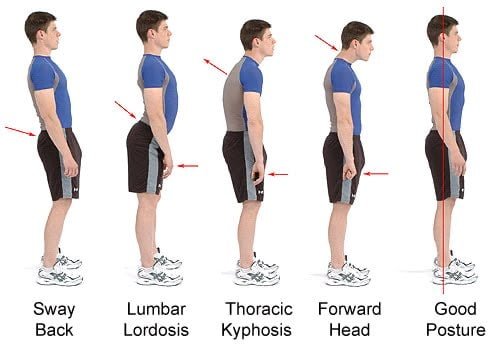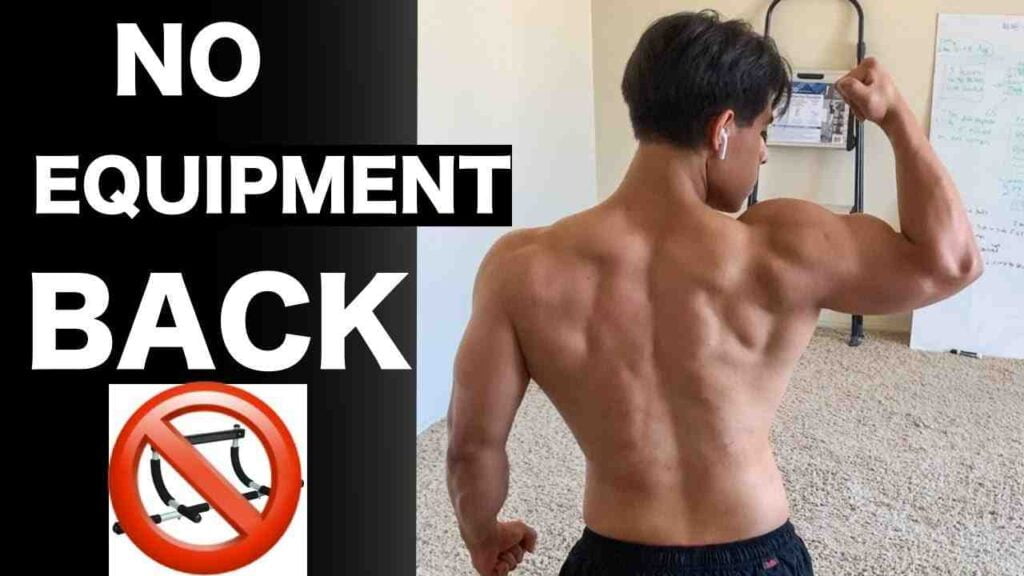Introduction
Are you ready to strengthen your lower back and experience a pain-free, more active life? Look no further than lower back cable exercises – your path to a robust, resilient lower back that supports your daily activities and enhances your overall fitness.
In today’s fast-paced world, maintaining a strong lower back is crucial. Whether you’re lifting groceries, playing with your kids, or just sitting at your desk, your lower back plays a pivotal role in your comfort and well-being. Sadly, lower back pain and discomfort are common complaints, affecting millions of people worldwide.
SHOP FOR THE ADJUSTABLE DUMBBELL SET ON AMAZON
But here’s the good news: You can take charge of your lower back health and banish those aches and pains with the power of targeted lower back cable exercises. In this comprehensive guide, we’ll walk you through everything you need to know about these exercises – from the basics to advanced techniques – ensuring you have the tools to craft a resilient and injury-resistant lower back.
Understanding the Lower Back
The lower back, often referred to as the lumbar region, plays a crucial role in our everyday lives. Whether you’re picking up groceries, sitting at your desk, or engaging in physical activities, your lower back is involved in almost every movement. Here, we’ll delve into the anatomy and function of the lower back, helping you gain a better appreciation for this essential part of your body.
Anatomy of the Lower Back
The lower back consists of the five lumbar vertebrae, numbered L1 to L5. These vertebrae are larger and more robust than those in the upper spine, as they bear a significant portion of the body’s weight and stress. In between each vertebra are intervertebral discs, which act as shock absorbers and provide flexibility to the spine.
SHOP FOR THE CABLE MACHINE ATTACHMENTS ON AMAZON
One of the key features of the lumbar spine is its lordotic curve, which means it curves slightly inward. This natural curvature helps distribute weight evenly, maintain balance, and absorb shock during movement. Muscles, ligaments, and tendons surround the lumbar spine, providing stability and facilitating various movements.
The function of the Lower Back
- Support and Stability: The lower back serves as the primary support for your upper body, helping you maintain an upright posture. It also stabilizes your spine, preventing excessive movement that could lead to injury.
- Movement: While the lumbar spine is not as flexible as the cervical (neck) or thoracic (upper back) regions, it still allows for crucial movements, such as bending forward, backward, and to the sides. These movements are vital for everyday activities.
- Protection: The lumbar vertebrae protect the spinal cord, a critical component of your central nervous system. Damage to the spinal cord can result in severe neurological issues, so its protection is paramount.
- Load Bearing: The lower back bears a significant portion of your body weight, especially when you lift heavy objects or engage in physical activities like running or jumping. It’s essential to keep these muscles and structures strong to prevent injury.
- Transferring Forces: The lower back helps transfer forces generated by the upper body and legs, allowing coordinated movement. This transfer of forces is crucial for functional activities like walking and standing.
Common Lower Back Issues
Despite its importance, the lower back is susceptible to various issues and injuries. Some common problems include:
- Lower Back Pain: This is one of the most prevalent issues. It can result from muscle strains, ligament sprains, herniated discs, or poor posture.
- Sciatica: Sciatic pain originates in the lower back and travels down the leg due to pressure on the sciatic nerve. It can be caused by herniated discs or bone spurs.
- Degenerative Disc Disease: Over time, the intervertebral discs can wear down, leading to pain and decreased mobility.
- Scoliosis: Abnormal curvature of the spine can affect the lower back, causing pain and postural problems.
- Spinal Stenosis: This condition involves the narrowing of the spinal canal, potentially compressing nerves and causing pain and weakness.
SHOP FOR THE WEIGHTLIFTING BELT ON AMAZON
Understanding the lower back’s anatomy and function is the first step in maintaining its health and preventing issues.
Why Choose Cable Exercises?
Choosing cable exercises for your lower back workouts offers several compelling advantages that make them a preferred choice for many fitness enthusiasts. Here’s why you should consider incorporating cable exercises into your routine:
- Constant Tension: Cable machines provide continuous resistance throughout the entire range of motion. Unlike free weights where the resistance may vary, cables keep your muscles engaged consistently. This constant tension helps stimulate muscle growth and strength effectively.
- Versatility: Cable machines offer a wide variety of attachments and settings, allowing you to perform numerous exercises that target different muscle groups, including the lower back. This versatility allows you to customize your workout routine to suit your fitness goals and preferences.
- Isolation and Targeting: Cable exercises enable precise targeting of specific muscles. When it comes to the lower back, this precision is vital as it helps you focus on strengthening this specific area, which can be challenging with other exercise methods.
- Safety: Cables are generally considered safer than lifting heavy free weights, especially for beginners. With proper form and technique, the risk of injury is significantly reduced. Plus, many cable machines come with built-in safety features like adjustable safety stops.
- Variation: Cable exercises can add variety to your workout routine. This variety is not only beneficial for keeping your workouts interesting and preventing boredom but also for preventing overuse injuries that can occur when you do the same exercises repeatedly.
- Stabilization: Cable exercises often require you to engage your core and stabilizer muscles to maintain balance and control throughout the movement. This enhances overall core strength and stability, which is essential for a healthy lower back.
- Progressive Resistance: Cable machines typically allow for easy adjustments in weight increments. This makes it convenient to gradually increase resistance as your strength improves, promoting continuous progress.
- Reduced Strain on Joints: Unlike some free-weight exercises that may place excessive stress on joints, cable exercises can be gentler on your joints, reducing the risk of joint-related injuries.
SHOP FOR THE FOAM ROLLER ON AMAZON
Cable exercises offer constant tension, versatility, and safety, making them an excellent choice for targeting and strengthening the lower back. By incorporating these exercises into your fitness routine, you can reap the benefits of improved lower back health and overall fitness.
Top Lower Back Cable Exercises
Here, we will explore some of the top lower back cable exercises that can help strengthen and stabilize your lower back. These exercises are not only effective but also easy to perform with proper guidance.
1. Cable Pull-Through
The Cable Pull-Through is a fantastic lower back exercise that also engages your glutes and hamstrings. It’s an effective way to improve posterior chain strength and stability.
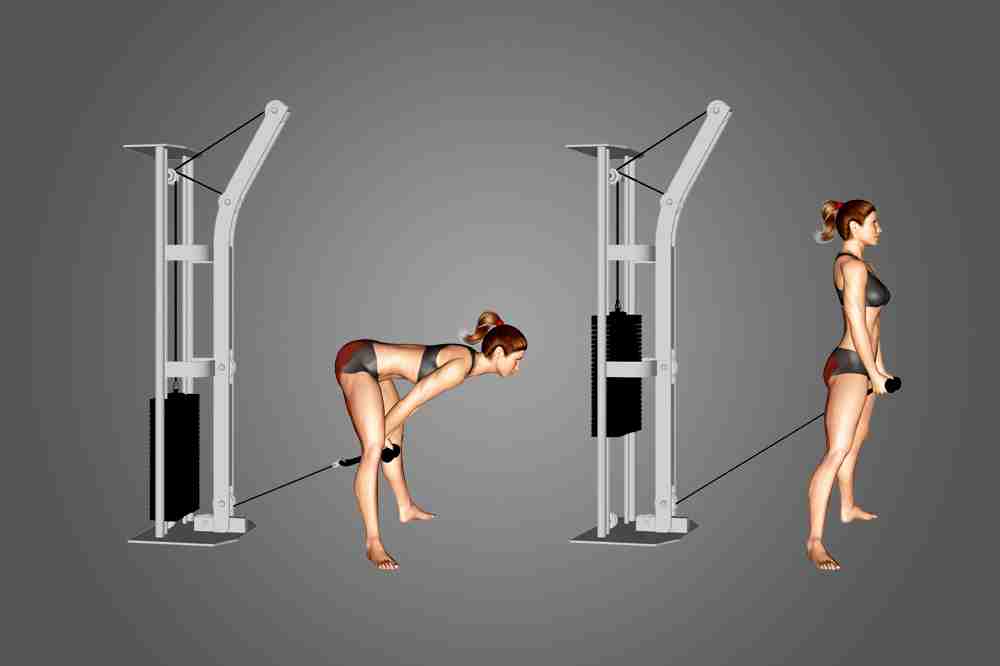
Step-by-Step Instructions
- Begin by setting up a cable machine with a low pulley attachment. Attach a rope handle.
- Stand facing away from the machine with your feet shoulder-width apart and the rope handle between your legs.
- Bend at your hips while keeping your back straight, and grab the rope handle through your legs.
- Start with the handle close to your body and your arms extended.
- Push your hips forward while standing up straight, pulling the rope through your legs and extending your hips fully.
- Squeeze your glutes at the top of the movement.
- Reverse the motion by pushing your hips back, allowing the rope to pass back through your legs.
- Keep your back straight throughout the exercise and maintain a slight bend in your knees.
Proper Form Tips
- Ensure your hips hinge back as you bend forward to engage your lower back and hamstrings effectively.
- Maintain a straight back throughout the movement to prevent any stress on your lower back.
- The Cable Pull-Through primarily targets your glutes, so squeeze them at the top of the movement for maximum activation.
2. Cable Romanian Deadlift
The Cable Romanian Deadlift is a lower back and hamstring exercise that helps with strength, stability, and flexibility.

Step-by-Step Instructions
- Set up a cable machine with a low pulley attachment and attach a straight bar.
- Stand facing the machine with your feet hip-width apart, and hold the bar with an overhand grip, hands shoulder-width apart.
- Start with the bar in front of your thighs and your arms fully extended.
- Keep your back straight as you hinge at your hips, lowering the bar by pushing your hips back.
- Lower the bar until you feel a stretch in your hamstrings or your back is nearly parallel to the floor.
- Maintain a slight bend in your knees throughout the movement.
- Push your hips forward to return to the starting position.
Proper Form Tips
- Keep your back straight, and avoid rounding or arching it during the exercise.
- Lower the bar slowly and under control to engage your muscles effectively.
- Focus on the hip hinge movement to engage your hamstrings and lower back.
3. Cable Seated Row
The Cable Seated Row is a great exercise for building a strong and well-defined upper back while also engaging the lower back muscles.
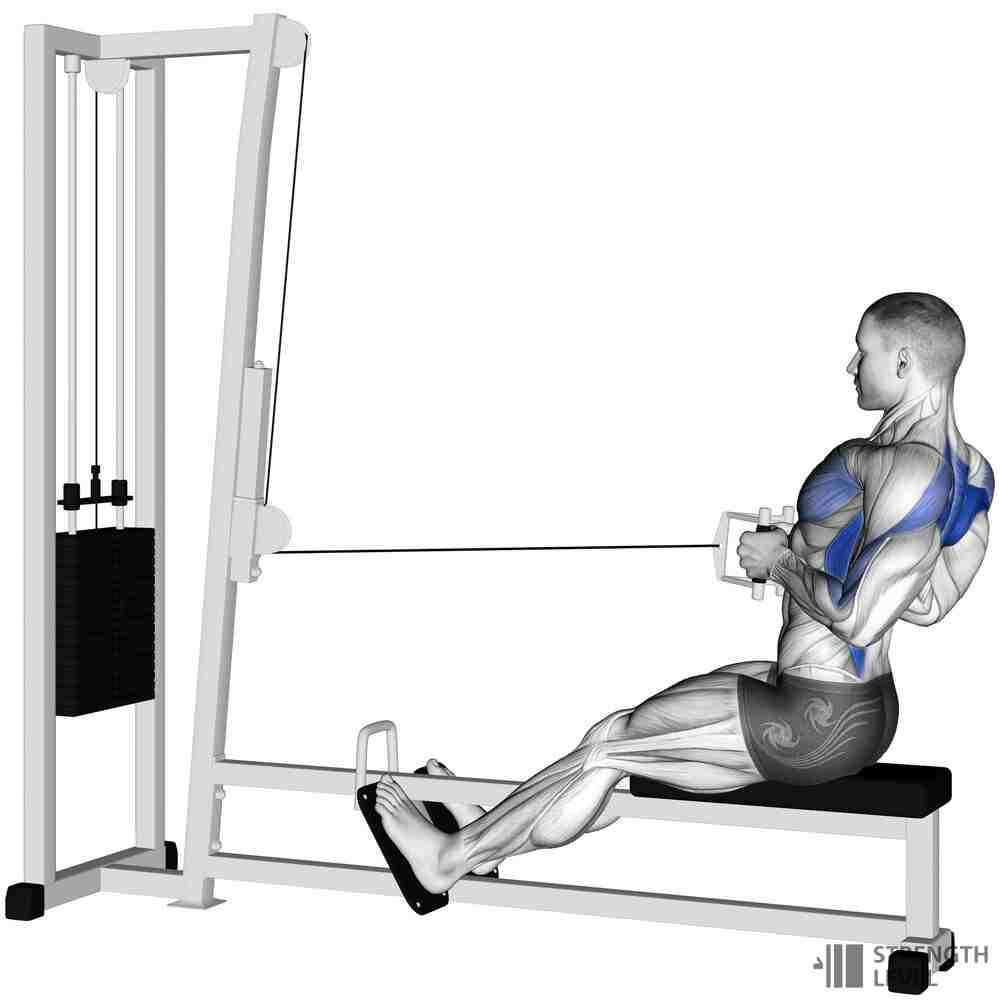
Step-by-Step Instructions
- Sit down at a cable row machine with your feet on the footrests, knees slightly bent.
- Grab the handle with an overhand grip, hands shoulder-width apart.
- Sit up straight, keeping your chest lifted and shoulders back.
- Begin the exercise with your arms fully extended, allowing your shoulders to protract.
- Pull the handle towards your lower ribcage while squeezing your shoulder blades together.
- Keep your back straight and maintain good posture throughout the movement.
- Slowly extend your arms to return to the starting position.
Proper Form Tips
- Avoid rounding or arching your back during the exercise to prevent unnecessary stress on your lower back.
- Use a controlled and deliberate motion to engage the target muscles effectively.
- Focus on the contraction of your upper back muscles as you pull the handle toward your body.
4. Cable Standing Row
The Cable Standing Row is an excellent exercise for targeting your upper back, traps, and lower back muscles, helping to improve overall back strength.
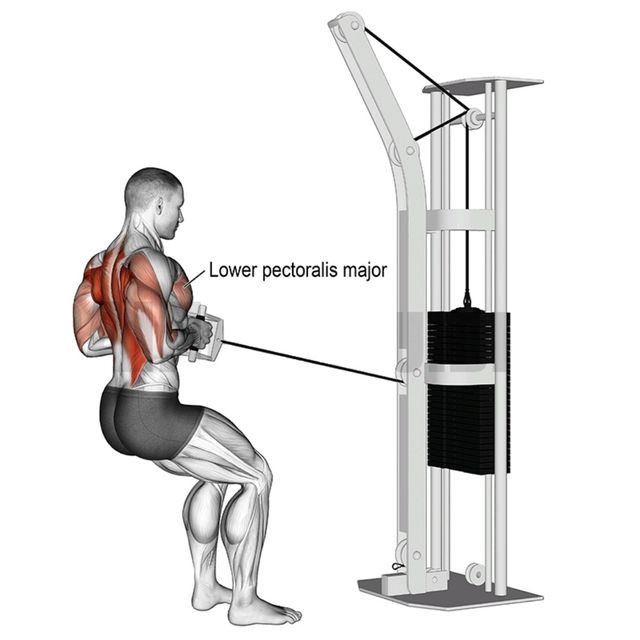
Step-by-Step Instructions
- Stand facing a cable machine with a straight bar attached to a high pulley.
- Grab the bar with an overhand grip, hands shoulder-width apart.
- Take a step back to create tension in the cable.
- Stand up straight with your feet hip-width apart and your arms fully extended.
- Pull the bar towards your lower ribcage while keeping your elbows pointed out to the sides.
- Squeeze your shoulder blades together as you bring the bar closer to your body.
- Slowly extend your arms to return to the starting position.
Proper Form Tips
- Keep your back straight and avoid using momentum to lift the weight.
- Emphasize the contraction of your upper back muscles as you pull the bar towards your body.
- Use controlled movements to engage the target muscles effectively.
5. Cable Straight-Arm Pulldown
The Cable Straight-Arm Pulldown is a great exercise for targeting the lats and lower back while improving shoulder mobility.

Step-by-Step Instructions
- Stand facing a high pulley cable machine with a straight bar attachment.
- Grab the bar with an overhand grip, hands wider than shoulder-width apart.
- Stand with your feet hip-width apart and a slight bend in your knees.
- Start with your arms fully extended, bar in front of your thighs.
- Keep your back straight and core engaged.
- Pull the bar down towards your thighs while keeping your arms straight.
- Focus on using your lats to initiate and control the movement.
- Slowly return the bar to the starting position.
Proper Form Tips
- Keep your back straight and avoid arching it during the exercise.
- Concentrate on using your lats to pull the bar down and avoid excessive involvement of your arms.
- Use controlled movements to target the intended muscles effectively.
6. Kneeling Cable Crunch
The Kneeling Cable Crunch is a core-strengthening exercise that also engages the lower back muscles.
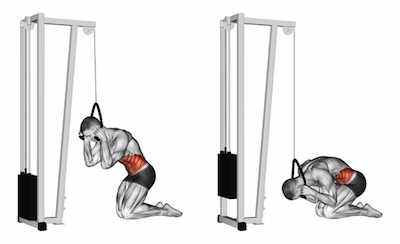
Step-by-Step Instructions
- Attach a rope handle to a high pulley cable machine.
- Kneel down facing away from the machine, holding the rope handle above your head.
- Keep your knees hip-width apart and your feet flat on the floor.
- Begin with your arms fully extended, and your torso upright.
- Engage your core and bend at the waist, bringing your elbows towards your thighs.
- Round your back slightly as you crunch down, exhaling as you contract your abs.
- Pause for a moment at the bottom of the movement to feel the contraction.
- Slowly return to the starting position, keeping tension on your abs.
Proper Form Tips
- Avoid excessive rounding of the lower back during the crunch.
- Squeeze your abdominal muscles at the bottom of the movement to maximize the effectiveness of the exercise.
- Perform the exercise with deliberate, controlled movements to engage your core effectively.
7. Lat Pulldown
The Lat Pulldown is a classic exercise that targets the latissimus dorsi (lats) and also engages the muscles of the lower back.
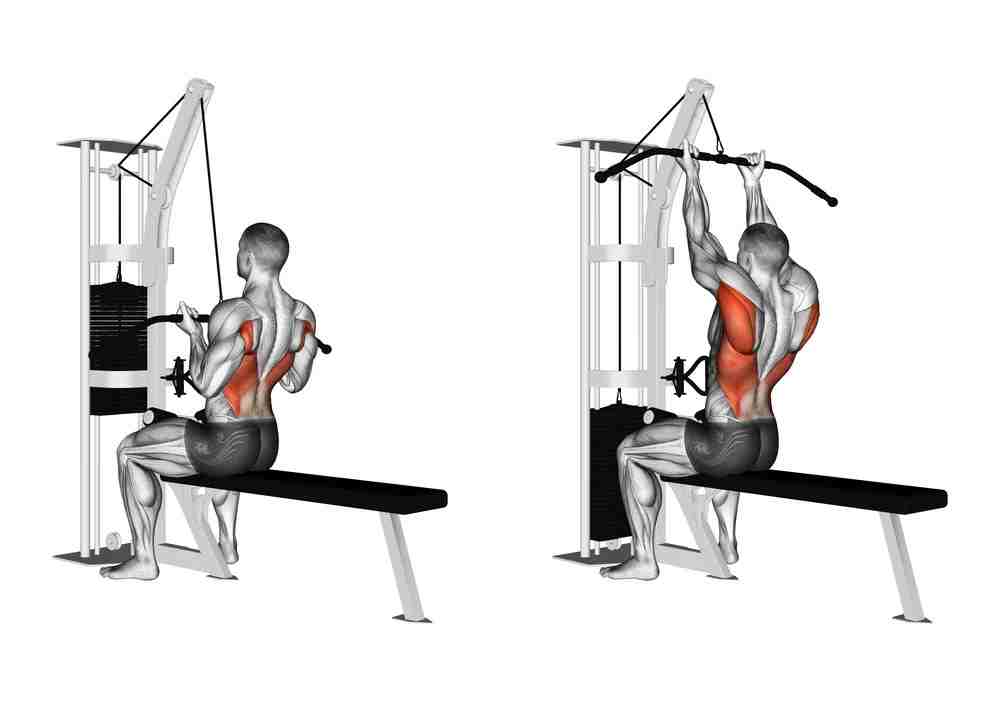
Step-by-Step Instructions
- Sit down at a lat pulldown machine and adjust the thigh pads to secure your legs.
- Grasp the wide bar with an overhand grip, hands wider than shoulder-width apart.
- Keep your back straight and chest up, and lean back slightly.
- Begin with your arms fully extended, and the bar above your head.
- Pull the bar down towards your upper chest, squeezing your shoulder blades together.
- Keep your elbows pointed out to the sides during the movement.
- Lower the bar back to the starting position, extending your arms fully.
Proper Form Tips
- Keep your back straight and avoid arching it during the exercise.
- Focus on engaging your lat muscles to initiate and control the movement.
- Perform the exercise with controlled movements to effectively target the intended muscles.
SHOP FOR THE FITNESS TRACKER ON AMAZON
These step-by-step instructions and proper form tips for each exercise will help ensure that you perform them safely and effectively, targeting the desired muscles while minimizing the risk of injury.
Benefits of Lower Back Cable Exercises
Lower back cable exercises offer several key benefits that make them a valuable addition to your fitness routine:
- These exercises specifically target the muscles in your lower back, helping to build strength and endurance in this crucial area.
- Strengthening your lower back can lead to better posture by providing the necessary support to maintain an upright position. This can reduce the risk of slouching and associated posture-related issues.
- Strengthening the lower back muscles can alleviate or prevent lower back pain. This is particularly beneficial for individuals who suffer from chronic discomfort in this area.
- Many lower back cable exercises engage not only the lower back muscles but also the core. This dual benefit promotes overall core strength, which is essential for stability and balance.
- A strong lower back contributes to improved stability in various physical activities, from lifting objects to participating in sports. Enhanced stability can help prevent injuries.
- When performed with proper form and technique, lower back cable exercises are generally safe and reduce the risk of injury compared to free-weight exercises that require balancing heavy weights.
Incorporating these cable exercises into your fitness regimen can yield noticeable improvements in lower back health, core strength, and overall physical performance, making them a valuable tool for achieving your fitness goals and maintaining a healthy, pain-free lower back.
Sample Lower Back Cable Workout Routine
Here is a sample lower back cable workout routine that you can try:
Warm-up
- 5 minutes of light cardio, such as jogging or jumping jacks
- 10-15 reps of each of the following exercises:
- Bird dog
- Superman
- Plank
Workout
- Cable Pull-Through: 3 sets of 10-12 reps
- Cable Romanian Deadlift: 3 sets of 8-10 reps
- Cable Seated Row: 3 sets of 10-12 reps
- Cable Standing Row: 3 sets of 8-10 reps
- Cable Straight-Arm Pulldown: 3 sets of 10-12 reps
- Kneeling Cable Crunch: 3 sets of 15-20 reps
Cool-down
- 5 minutes of light cardio
- Stretching for your lower back and hamstrings
You can adjust the number of sets and reps to fit your fitness level. Be sure to listen to your body and take breaks when needed.
FAQs
Q 1. Can anyone do lower back cable exercises, or are they only for advanced fitness enthusiasts?
Ans. Lower back cable exercises can be adapted for various fitness levels. Beginners should start with lighter weights and focus on proper form. Consult with a fitness trainer if you’re unsure about your suitability for these exercises.
Q 2. How often should I incorporate lower back cable exercises into my workout routine?
Ans. It’s recommended to perform lower back cable exercises 2-3 times a week, allowing at least one day of rest in between sessions. Listen to your body and adjust the frequency as needed.
Q 3. Are there any precautions I should take before starting lower back cable exercises?
Ans. Before beginning any exercise program, it’s essential to consult with a healthcare professional, especially if you have any pre-existing medical conditions or a history of lower back injuries. Ensure that you have proper footwear, and always use the correct form to prevent injury.
Q 4. How do I progress in lower back cable exercises to keep seeing results?
Ans. To continue seeing progress, you can increase the weight you lift gradually. You can also modify exercises, incorporate different variations, or change the order of exercises in your routine to challenge your muscles differently.
Q 5. Is it normal to feel soreness in the lower back after these exercises?
Ans. Some muscle soreness, especially when you’re starting or changing your routine, is normal. However, if you experience sharp or prolonged pain, you should stop the exercises and consult a healthcare professional.
Q 6. Can I perform these exercises at home, or do I need access to a gym with cable machines?
Ans. You can perform some variations of lower back cable exercises at home with resistance bands or cables attached to a sturdy anchor point. However, for a full range of cable exercises, you may need access to a gym with cable machines.
Conclusion
In conclusion, lower back cable exercises are a powerful tool for enhancing the strength and stability of your lower back, ultimately contributing to better overall health and well-being. Understanding the importance of a strong lower back and choosing cable exercises as part of your fitness routine can lead to improved posture, reduced pain, and increased core strength.
By following the provided instructions and tips, you can safely and effectively incorporate these exercises into your workout regimen. Remember to start with the appropriate weight and progress gradually to avoid injury.

Good day, and welcome to Fitthour. My name is Shubham Vijay, and I am a certified personal trainer and nutrition coach with 6 years of experience in the fitness industry. At Fitthour, we specialize in types of training, such as strength training, cardio, or HIIT, and our mission is to help clients achieve their fitness goals and improve their overall health.

